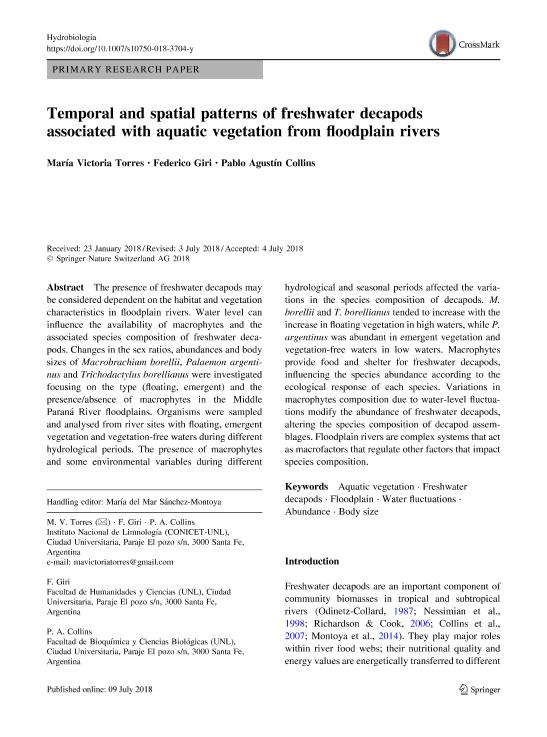Mostrar el registro sencillo del ítem
dc.contributor.author
Torres, María Victoria

dc.contributor.author
Giri, Federico

dc.contributor.author
Collins, Pablo Agustin

dc.date.available
2019-11-11T18:09:56Z
dc.date.issued
2018-11
dc.identifier.citation
Torres, María Victoria; Giri, Federico; Collins, Pablo Agustin; Temporal and spatial patterns of freshwater decapods associated with aquatic vegetation from floodplain rivers; Springer; Hydrobiologia; 823; 1; 11-2018; 169-189
dc.identifier.issn
0018-8158
dc.identifier.uri
http://hdl.handle.net/11336/88492
dc.description.abstract
The presence of freshwater decapods may be considered dependent on the habitat and vegetation characteristics in floodplain rivers. Water level can influence the availability of macrophytes and the associated species composition of freshwater decapods. Changes in the sex ratios, abundances and body sizes of Macrobrachium borellii, Palaemon argentinus and Trichodactylus borellianus were investigated focusing on the type (floating, emergent) and the presence/absence of macrophytes in the Middle Paraná River floodplains. Organisms were sampled and analysed from river sites with floating, emergent vegetation and vegetation-free waters during different hydrological periods. The presence of macrophytes and some environmental variables during different hydrological and seasonal periods affected the variations in the species composition of decapods. M. borellii and T. borellianus tended to increase with the increase in floating vegetation in high waters, while P. argentinus was abundant in emergent vegetation and vegetation-free waters in low waters. Macrophytes provide food and shelter for freshwater decapods, influencing the species abundance according to the ecological response of each species. Variations in macrophytes composition due to water-level fluctuations modify the abundance of freshwater decapods, altering the species composition of decapod assemblages. Floodplain rivers are complex systems that act as macrofactors that regulate other factors that impact species composition.
dc.format
application/pdf
dc.language.iso
eng
dc.publisher
Springer

dc.rights
info:eu-repo/semantics/openAccess
dc.rights.uri
https://creativecommons.org/licenses/by-nc-sa/2.5/ar/
dc.subject
ABUNDANCE
dc.subject
AQUATIC VEGETATION
dc.subject
BODY SIZE
dc.subject
FLOODPLAIN
dc.subject
FRESHWATER DECAPODS
dc.subject
WATER FLUCTUATIONS
dc.subject.classification
Ecología

dc.subject.classification
Ciencias Biológicas

dc.subject.classification
CIENCIAS NATURALES Y EXACTAS

dc.title
Temporal and spatial patterns of freshwater decapods associated with aquatic vegetation from floodplain rivers
dc.type
info:eu-repo/semantics/article
dc.type
info:ar-repo/semantics/artículo
dc.type
info:eu-repo/semantics/publishedVersion
dc.date.updated
2019-10-25T18:52:34Z
dc.journal.volume
823
dc.journal.number
1
dc.journal.pagination
169-189
dc.journal.pais
Alemania

dc.journal.ciudad
Berlin
dc.description.fil
Fil: Torres, María Victoria. Consejo Nacional de Investigaciones Científicas y Técnicas. Centro Científico Tecnológico Conicet - Santa Fe. Instituto Nacional de Limnología. Universidad Nacional del Litoral. Instituto Nacional de Limnología; Argentina
dc.description.fil
Fil: Giri, Federico. Universidad Nacional del Litoral. Facultad de Humanidades y Ciencias. Departamento de Ciencias Naturales; Argentina
dc.description.fil
Fil: Collins, Pablo Agustin. Consejo Nacional de Investigaciones Científicas y Técnicas. Centro Científico Tecnológico Conicet - Santa Fe. Instituto Nacional de Limnología. Universidad Nacional del Litoral. Instituto Nacional de Limnología; Argentina
dc.journal.title
Hydrobiologia

dc.relation.alternativeid
info:eu-repo/semantics/altIdentifier/doi/http://dx.doi.org/10.1007/s10750-018-3704-y
Archivos asociados
